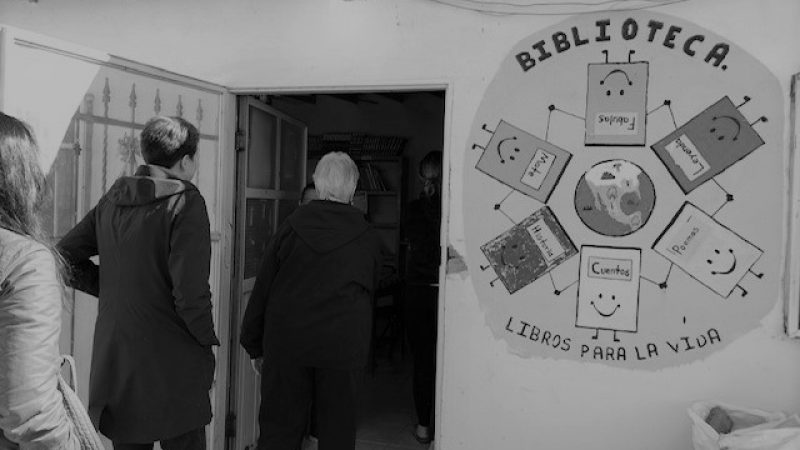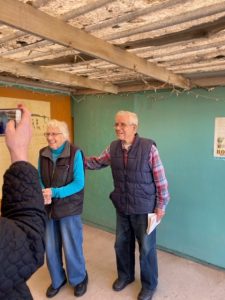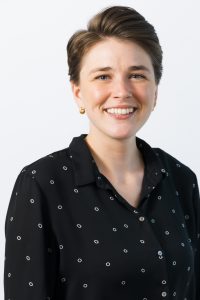March 2, 2020

Rachel Drotar, Program Coordinator, Generative Spirit, reflects on a recent trip to the Mexico-U.S. border organized through the Assembly of Catholic Foundations.
Presente in Juarez
We walked through the gate into a three-room home for our first visit across the border. The house was decorated simply with newspaper clippings and images of the Salvadoran martyrs, and folded Christmas cards balanced on a clothesline above our heads. A circle of metal folding chairs were set for us in a circle. This Catholic Worker house in Cuidad Juarez was the home of Peter and Betty, People Religious living together in community with their neighborhood. The two introduced themselves and told us the history of their home, their work, and the challenges that faced the people they dedicated their lives to.

They walked us outside to a set of painted murals; one had an image of open hands, another of families walking together, a map of Mexico, arms outstretched, black crosses on pink backgrounds. These living documents listed the names of those murdered, kidnapped, and lost, and were continually updated with each new group that visited Betty and Peter. Each mural included hundreds of names: families, migrants, reporters and women.
This mural served to not forget. We each pulled slips of paper with the name of someone lost and read aloud their names, ages and the date they were murdered or disappeared. After each one read, we repeated a litany of “presente,” meaning “here” or “present,” and added the names to the murals.
“Response” was a major theme of our time immersed in Juarez, Mexico and El Paso, Texas. Betty relayed a phrase from Pope Francis’s trip to Juarez in 2016: “God is in Juarez.” I believed it then and even more now, after I’ve had time to reflect. That sentiment encompasses the hope that was felt among such suffering.
Within the stories of struggle, the response by the people in both cities was incredible. I cannot emphasize enough how much community members mobilized when the authorities released hundreds—and at one point 1,000—migrants a day into El Paso with little support to get to their families or loves ones. Immense amounts of volunteers from Annunciation House, including their director Reuben Garcia, found places for these migrants to stay and assistance to get to their destination. They remain a community of care and compassion.
The Gospel and Privilege
We entered into understanding this issue from multiple entry points: the stories of migrants, the policies that affected their lives, and the response from community members, advocates, and service providers.
It is important to experience, to notice, and to learn, but reflection on experiences is what leads to authentic action. If I didn’t take action based on what I heard, I felt the people we met would be telling their stories in vain to a white woman who could go back to her life like nothing happened. I feel sick when I think of this possibility—mostly because it is true. I will struggle and I will feel like I failed the people that shared their story with me. How do I ensure that I take action and do not return to my comfortable life?
At first, I was nervous about going on the trip for fear of being a consumer of stories, all to report back what I saw without action or change behind it. I didn’t want others to be used, especially those who have experienced trauma and oppression at the hands of corporations, gang violence, corrupt governments, and injustice at the border. I was aware of my position as someone who had an opportunity to “experience” the issues at the border, with the privilege to go back to Ohio and “go back to my life.” It was important for me to consider the political, racial, and power dynamics that would be present during this experience, but I was self-conscious of doing, or not doing, the right thing. I am still not convinced that we did good work. Did we do harm? Does learning and leaving negatively impact the communities we met?
I considered the gospel: What is the work of the gospel? Where does it show up? What does it say about participation and action, or lack of action? What does it say about privilege? Where is Jesus present in our experience?
Now What?
We met Brother Todd, a Marist brother who was one of our hosts and guides during the week. Through Brother Todd and Fr. Rafael, SJ, we learned about the layers of relationships they had within the community of El Paso and Juarez.
Brother Todd challenged us to consider three questions that he uses with groups in immersion experiences: “What?” “So What?” “Now What?”
What?” is right in front of you. The people and places you meet. The setting. The policies. What is heard and smelled. The reality you experience in physical, visual form. “So What?” are the feelings you have as a result of what you saw or experienced. What does this information do to you? How do you react to seeing this injustice, hearing these stories, understanding how policies have played out for migrants? Finally, “Now What?” is the action space. What do you do, now that you have learned and noticed what it has done to you?
Brother Todd wanted us to remain in the “What?” during our time in El Paso and Juarez. Too often our minds want to jump to a solution to what is presented as a way to take the away the discomfort we feel. When presented with hard truths about the world – oppression, economic destabilization by governments, the complacency of the United States – we were challenged to stay in those spaces and be immersed in the reality of the situation. We all needed reminders to stay focused on the “What?” of our experience. What was in front of us? Who did we meet and what was their story? What communities were they part of and what communities had they left? Who were their families? What made them laugh? What violence where they fleeing?
Once we left El Paso and Juarez, I tried to remember to stay in the “What?” as I slowly unpacked the experience with co-workers and friends. Before trying to clean up the pain or coming up with solutions, we have to consider that God is already in the “What?”— a fire that keeps us accountable. If we do not remember and recount the “What?” we forget the fire we felt and the intentions we set to remain engaged, entering back into our comfortable lives.
God is present in the What:
In Betty’s words. In the struggle and in what keeps her coming back.
In the writing on the mural wall. In its urgency.
In the panicked words of a mothers’ reflection during mass at a shelter for migrants released from ICE. In her son, his hands gripping hers.
In the response of Father Rafael, of Betty, of Brother Todd, of Reuben.
God is present in the What.

Rachel Drotar, Program Coordinator, Generative Spirit